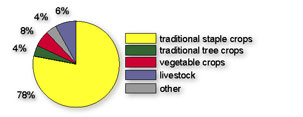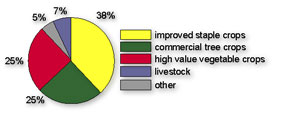The situation in Haiti
The recent upheavals following the 2010 earthquake have left Haitian farmers poorer than ever. As world events turn our attention towards other crisis areas, important programs that could help the Haitian farmers are often being put on hold. The pressure is on a rural population struggling to find its direction in a bankrupt environment. Opportunities abound, but could permanently fade away if neglected. Haitian farmers are so undercapitalized that without external support they will be unable to create and manage competitive agricultural endeavors. And they have repeatedly demonstrated that given means (the guidance, technical support and necessary agricultural materials) they can and will sustain economic growth based on the production and marketing of improved commercial crops.
- env-04
Haiti is faced with severe environmental damage due to deforestation
- env-32
Less than 3% of the original tree cover remains, and the mountains are scarred with soil erosion and ever-widening ravines.
- env-33
Trees are cut down on the mountains, and the slopes are planted with cash crops for a few seasons, until the soil washes downhill and out to sea.
- env-05
Deforestation has eliminated all but a tiny percentage of the country's original tree-cover and the soil from once fertile lands quickly erodes.
- env-06
Slash and burn farming is still widespread - being a cheap and easy way to clear land to grow seasonal crops likes beans and corn.
- env-34
You cannot fail to admire the hard work that goes into farming such steep slopes - although sadly the exposed top-soil will wash away in a few years.
- env-09
As tree-cutting and charcoal production progress once fertile areas gradually become barren due to soil-erosion.
- env-10
Charcoal is a major cash crop, as it is always in demand as the main source of cooking fuel.
- env-11
Tons of charcoal are consumed daily in the capital Port-au-Prince while the tree cover continues to dwindle. An alternative solution must be found if the country is to survive.
- env-12
Fertile lands in the lowlands are subject to flash-floods from the eroded hillsides upstream. These floods can destroy crops and property, covering arable land with rocky sediment, making it worthless for agriculture.
- env-13
Flooding increases in line with the deforestation. Roads, towns and property are destroyed by increasingly frequent flooding.
- env-29
The value of a tree is often only in its wood products, which is why propagating grafted mangos and other commercial fruit trees (which earn more every year in cash than their wood-value) is so important.
- env-31
Trees that earn good money annually are very rarely ever cut down.
- env-30
Overpopulation leads to increasing pressure on the environment. Everyone needs fuel to cook and trees are often the most readily-available source of cash.
- env-01
The agricultural system is still based on subsistence farming with outdated technologies. The seeds and plant material are rarely selected for better performance, and crop yields are generally very low.
- env-02
The majority of farmers focus on growing enough food to feed their families and selling the balance in small local markets, rather than as a market-driven commercial enterprise.
- env-03
Tobacco being transported from the field in an ox-drawn cart.
- env-14
Micro regions with partially wooded, fertile lands and irrigation systems still survive - and farmers are relatively prosperous, growing abundant fruits, vegetables and other crops.
- env-15
Once erosion from deforestation causes sediment to block and bury irrigation canals local agriculture shifts from high to low revenue crops - and the population becomes poorer and less well nourished.
- env-21
This young girl's yellow hair is a sign of Kwashiorkor from malnourishment
- env-23
During the mango and avocado seasons signs of malnutrition decease especially in children.
- env-19
Children collecting water from a spring. It is estimated that every family spends on average 6 hours a day in collecting water.
- env-22
Cooking traditional rice and beans on an open fire. Often a primitive setup but a delicious taste!
- env-24
The rural community takes care of it's basic needs with artisanal but effective technologies
- env-26
The rural economy often relies on small-scale commercial activities to bolster income from agriculture.
- env-28
Washing day by the river is a regular fixture throughout rural Haiti
- env-16
As the plight of the rural population worsens many migrate to Port-au-Prince in the hopes of a better future - though unfortunately the majority live under harsh conditions in the city's many slums.
- env-17
Even before the 2010 earthquake Port-au-Prince was over crowded, lacked urban planning and proper infrastructure. Today the challenges are far worse.
- env-27
Haitians can display inexpressible charm and good humour even in the most difficult conditions.
ORE has been working in Haiti since 1985
Take a look at what people have been saying about us and our program history.

Dr. Mousson Pierre Finnigan, CEO of ORE Haiti, was among 15 women selected
for the national first award of 'Femmes de Mérite' en 2009.






